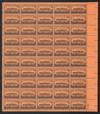
1956 3¢ Nassau Hall
# 1083 - 1956 3¢ Nassau Hall
$0.35 - $21.00
U.S. #1083
1956 3¢ Nassau Hall, Princeton University
1956 3¢ Nassau Hall, Princeton University
Issue Date: September 22, 1956
City: Princeton, New Jersey
Quantity: 122,100,000
Printed by: Bureau of Engraving and Printing
Printing Method: Rotary Press
Perforations: 11 x 10 ½
Color: Black, orange
City: Princeton, New Jersey
Quantity: 122,100,000
Printed by: Bureau of Engraving and Printing
Printing Method: Rotary Press
Perforations: 11 x 10 ½
Color: Black, orange
U.S. #1083 was issued to celebrate the 200th anniversary of Princeton Universities Nassau Hall. At the time it was built in 1756, Nassau Hall was the largest building in New Jersey.
U.S. #1083
1956 3¢ Nassau Hall, Princeton University
1956 3¢ Nassau Hall, Princeton University
Issue Date: September 22, 1956
City: Princeton, New Jersey
Quantity: 122,100,000
Printed by: Bureau of Engraving and Printing
Printing Method: Rotary Press
Perforations: 11 x 10 ½
Color: Black, orange
City: Princeton, New Jersey
Quantity: 122,100,000
Printed by: Bureau of Engraving and Printing
Printing Method: Rotary Press
Perforations: 11 x 10 ½
Color: Black, orange
U.S. #1083 was issued to celebrate the 200th anniversary of Princeton Universities Nassau Hall. At the time it was built in 1756, Nassau Hall was the largest building in New Jersey.









